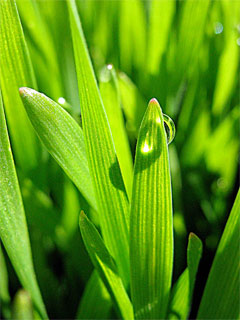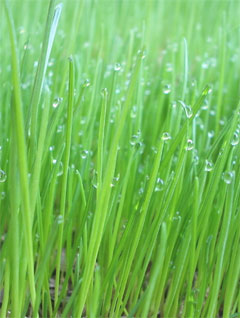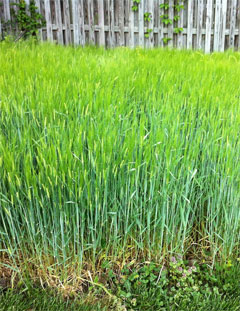|
|
Barley Grass: A complete super food

Hordeum murinum, commonly known as wall barley or false barley, is a species of
grass. It can grow to 30 cm in height and its unbranched spikes can reach 10 cm
long. It is quite widespread and common. It flowers during May through July in
mainly costal areas. It produces small, dry nutlets and its leaves can be 8 mm
wide with short, blunt ligules.
In the United Kingdom it is absent throughout most of Ireland and Scotland but
is common in England and Wales.
Barley grass is said to have 30 times more vitamin B1 and 11 times the amount of
calcium than there is in cow�s milk, 6.5 times as much carotene and nearly 5
times the iron content of spinach, close to seven times the vitamin C in
oranges, four times the vitamin B1 in whole wheat flour, and 80 micrograms of
vitamin B12 per 100 grams of dried barley plant juice.
Barley grass is very high in organic sodium, which dissolves calcium deposited
on the joints and also replenishes organic sodium in the lining of the stomach.
This aids digestion by improving the production of hydrochloric acid in the
stomach. People with arthritis have used celery juice for years because of the
organic sodium it contains (28mg per 100grms), but compare this to the amount of
organic sodium in barley grass (775mg per 100 grams).
Barley grass, at the time it is harvested to make juice, is about 45 percent
protein. It has almost twice as much protein as an equivalent amount of wheat
germ and about five times the minerals which accompany animal protein, in
addition the protein in barley grass doesn't come burdened with fat.
Enzymes (barley grass is believed to contain up to 1,000 of them) are the
necessary regulators of the body, without them our cells could not function and
we would perish. Barley grass has one of the highest natural levels of enzyme
SOD (superoxide dismutase), which is a powerful antioxidant that protects the
cells against toxic free radicals, thought to be a primary culprit in aging.
Barley grass also contains one of the most amazing nutrients, �chlorophyll
�(liquid oxygenated sunshine), a natural detoxifier that rids the intestines of
stored toxins.
Sure, you don't have to drink green grass juices to get chlorophyll; it is
present in all dark green, leafy vegetables. But the question is � how many
servings of spinach, kale, collards, mustard greens, or turnip and beet tops, do
you eat everyday?" Some people eat none�ever! And for those who do eat them
regularly, there is, after all, a limit to the amount of spinach, kale and the
likes someone can eat.
 Getting chlorophyll by taking barley grass is as easy as mixing 1-2 tsp, two
times a day, in water or you favourite juice. For those who want to spend even
less time getting their essential nutrients, simply take barley grass capsules
or tablets with a glass of water. Getting chlorophyll by taking barley grass is as easy as mixing 1-2 tsp, two
times a day, in water or you favourite juice. For those who want to spend even
less time getting their essential nutrients, simply take barley grass capsules
or tablets with a glass of water.
The importance of green foods in our diet is now being validated scientifically.
Dehydrated cereal grasses compare favourably with other greens in respect to
both nutrients and cost. It is an excellent and convenient source of green food
nutrients.
Green food nutrients support healthy blood and circulation. Iron, folic acid,
vitamin C, vitamin B12, pyridoxine and protein are all vital for the formation
and maintenance of adequate levels of hemoglobin and red blood cells.
Chlorophyll may also be beneficial in these processes. In addition, chlorophyll,
vitamin K, and calcium are all involved in blood clot formation and breakdown.
Users of barley grass have also found it useful as an aid in weight loss and
good for the heart, healing of ulcers, correcting blood sugar problems and, most
of all, as a general tonic.
Barley grass (Hordeum vulgare) has been a favorite among health enthusiasts for
centuries. It is usually consumed as a powder or liquid, but is also used to
make barley malt. Barley grass is considered a superfood, because of its
incredibly dense nutritional profile. It contains a wide variety of vitamins,
minerals, enzymes, and amino acids. Barley grass contains an abundance of
chlorophyll, and is rich in Vitamins A, B, C, iron and calcium. It also contains
high amounts of the electrolyte minerals potassium, magnesium, and phosphorus.
Barley grass is rich in plant enzymes and antioxidants. Clinical studies
involving the ingestion of barley grass powder show that it improves the health
of diabetic patients. Barley grass has been proven to reduce cholesterol and can
be used as a weight loss supplement.
Type 2 diabetes mellitis is by far the most prevalent type of diabetes among
adults. In a 2010 medical study, it was suggested that medicinal plants might
have therapeutic effects on complex diseases such as diabetes. Barley grass
powder was selected because of its reported benefits. The experimental group of
diabetics took 1.2 g of barley grass capsules every day for sixty days. The
control group took no supplementation. No other changes were made, and no other
alternative measures were taken. The patients' fasting blood sugar and lipid
profiles were taken at the beginning and end of the study.
Supplementing with barley grass powder caused a significant fall in the fasting
blood sugar level of the experimental group. No change was noted in the control
group. There was a 5.1% reduction in overall cholesterol levels after two
months. The researchers also noted that the risk of coronary heart disease was
significantly reduced in the diabetics who took barley grass supplements.
In a clinical study involving men with high LDL and total blood cholesterol
levels, taking 15 grams of barley grass extract daily significantly lowered
cholesterol levels. In addition, HDL, which is commonly referred to as "happy"
or "good" cholesterol, was increased by taking barley grass extract.
 In-vitro demonstration shows that barley grass extract scavenges free radicals.
Scientists think this is due to an exchange of hydrogen ions which makes the
free radicals weaker. Laboratory studies using the blood and spinal fluid of
rheumatoid arthritis patients noted that barley grass extract does exhibit
antioxidant properties. In-vitro demonstration shows that barley grass extract scavenges free radicals.
Scientists think this is due to an exchange of hydrogen ions which makes the
free radicals weaker. Laboratory studies using the blood and spinal fluid of
rheumatoid arthritis patients noted that barley grass extract does exhibit
antioxidant properties.
Barley is a type of grain and its grass is classified as a cereal grass. Juice
from the grass of mature barley may be extracted to produce a nutritional drink.
There are an abundance of vitamins and minerals found in barley grass juice,
which means health benefits will be bountiful. The juice can support the immune
system and provide the building blocks for growing bodies.
Supplements featuring grass from mature barley may also contain significant
amounts of dietary fiber. In fact, there may be more fiber from this cereal
grass than in a full serving of many green leafy vegetables. Fiber is essential
for the body's digestion process. Some experts believe that fiber may also help
ward off certain types of disease, such as colon cancer.
Obtaining a good source of protein is another benefit of the consumption of this
wheat grass. Protein is crucial for development and maintenance of cells, which
helps keep tissue, muscles, skin, bones, and vital organs healthy. Supplements
containing this cereal grass may contain more protein than a powdered protein
nutritional drink.
Dated 19 November 2013
|
|
|
|
|









